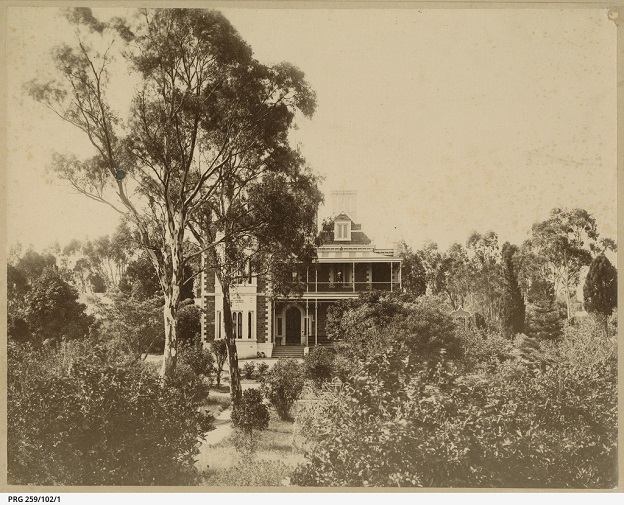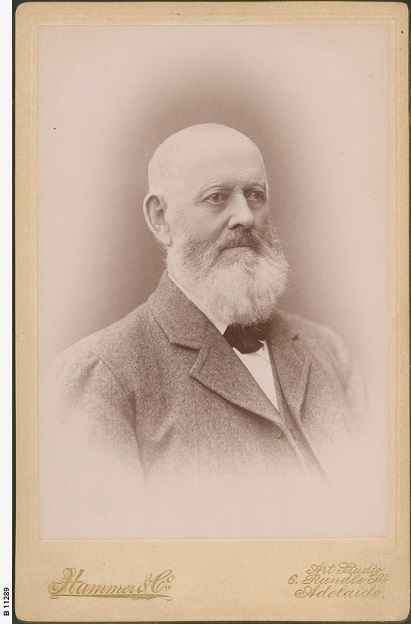Murray Park House

MURRAY HOUSE, MURRAY PARK MAGILL
Murray House PRG 259/102/1 circa 1903 courtesy of The State Library of South Australia.
Today it is the administrative centre of the University of South Australia, Magill Campus. Murray House, a fifteen room stone house, was acquired by the Department of Education in 1968 from its last owner, Mrs Ellinor Doris Bush, who trained and bred show horses on the property. Murray House is the second house to be built on this site; nothing now remains of the former residence, as it was demolished to make way for the current house in 1881. 1 The original builder of the second house on Murray Park was Alexander Borthwick Murray (1816-1903) and it was extended in 1910, by his son, who inherited the property on the death of his father.
Alexander Borthwick Murray arrived in South Australia as a full fare paying passenger on the Lady Lillford, arriving at Holdfast Bay on the 27th of September 1839. He was contracted by a cousin, Sir James Malcolm, to help his son, William Oliver Malcolm, in the care of sheep on his Barossa Property. 2

Alexander Borthwick Murray
B11289 circa 1885 courtesy of The State Library of South Australia.
Alexander Borthwick Murray was born in Langshall Burn, Dumfriesshire, Scotland, and was successful in breeding and acclimatizing Cheviot sheep to the Highlands of Inverness and Ross-shire. His appointment by his cousin was a success, as his sheep took out first prize at the very first rural show in South Australia. 3 In 1842 he married Charlotte Murthwaite Scott in Sydney, and returned to South Australia with his new bride and her sister. Charlotte’s sister was later to marry Alexander’s brother P.M. Murray.
Alexander purchased a property at Mount Crawford by special survey which he named Murray Vale, and began to grow wheat.4 This was not a success, for a number of reasons. The cost of transporting his wheat to the nearest mill at Kent Town, plus the onset of smut or common bunt, a fungi that attacks wheat in spring or winter. This combined with low wheat prices, due to a recession, led him to concentrate on sheep, cattle and horses at Mount Crawford. When Alexander purchasing some Merino ewes and a ram, in partnership with his sister in law, Mrs. P.M. Murray. The Merinos, which had been bred in New South Wales, were the foundation of the famous Murray Flocks. In 1855 Alexander sold the Mount Crawford property to his brother John Murray. He then built a home on his Tungkillo property.
By 1862 he owned properties at Murray Park, Magill, and Wirrabara in the mid north also Bookpurnong on the river Murray. Murray Town in the mid north is named in his honour. He became the elected member for Gumeracha in the House of Assembly in 1862 and in 1869 became a member of the Legislative Council. He retired from political life in 1888 after 28 years serving the people of South Australia.
Alexander’s first wife, Charlotte died in 1853. Only one child survived from this marriage. She became Mrs. Esther Gault of Lorne Avenue Magill. In June 1857 Alexander married for a second time, his second wife, Margaret Tinline, was the daughter of George Tinline, who was the accountant for the Bank of South Australia. When the Bank of South Australia suffered severe losses, due to a customer defaulting, George was blamed and sacked; he then became a partner in business with Alexander Borthwick Murray. 5 The second marriage produced four children, Margaret, George, Charlotte and Malcolm. Alexander Borthwick Murray died in 1903 and is buried in St George Anglican Church at Woodforde.
Upon the death of his father, George became the owner of Murray House. He had extensions carried out in 1910. George became Sir George John Robert Murray, Chief Justice of South Australia. He succeeded Sir Samuel Way, and was also the chancellor of the university, a position he held for twenty five years. As the states Lieutenant Governor he was the King’s representative on occasions of the Governor being absent, or in between appointments of new Governors. He performed this duty over so long a period, it was stated, his temporary duty as Governor, was far longer than any serving Governor. 6 Educated in Adelaide, he went on to study Law at Trinity College Cambridge in England. 7 The Tinline scholarship in History, which he created and funded, was named in honour of his mother. He never married and lived with his sister Margaret, who also never married, in Murray House. He died in 1942 after an operation for appendicitis, and was buried next to his sister Margaret, at St. George’s Anglican Church Woodforde. Charlotte Mary Murray married Frank Hagger Downer, at St. George Anglican Church at Woodforde on 8th of August 1900. Frank was the son of Henry Edward Downer and Maria nee Hagger. Lottie, as she was known died in 1921 and Frank died of tuberculosis in 1938. 8
Pultney Malcolm Borthwick Murray ran Wirrabara Station the mid north property purchased by Alexander Borthwick Murray. He led a troubled existence, finally taking his own life, on the Wirrabara property in 1900. 9 A local curio, attributed to Malcolm, is the clock in the Wirrabara Hotel. When the landlord called time gentlemen please at closing time, Malcolm shot the clock on the hotel wall. He replaced it later with a new clock; the old clock stuck at 6.00 pm can still be seen in the Hotel today, it is reported.
Sir George John Robert Murray Photo B47713 courtesy of the State Library of South Australia.
Researched and compiled by Jim Nelson, a volunteer with the Campbelltown Library “Digital Diggers” group.
If you have any questions or comments regarding this local history article, please contact Helen Thiselton at the Campbelltown Library hthiselton@campbelltown.sa.gov.au
References
- Stately Homes of Adelaide the Mail 28th July 1928 Page 13
- The Death of Mr. A.B. Murray the Register 18th March 1903 Page 8.
- The Cattle Show the Register 20th of November 1850 page 3.
- The Death of Mr. A.B. Murray the Register 18th March 1903 Page 8.
- Christine Hurst, Tinline George (1815-1895) Australian Dictionary of Biography.
- Death of Sir George Murray the News 18th February 1942 Page 3
- 60 Today Sir George Murray the News September 27th 1923 Page 8
- The Downers of Adelaide by Alick Downer Page 84-85
- S.A. Register 11th of April 1900 page 7
